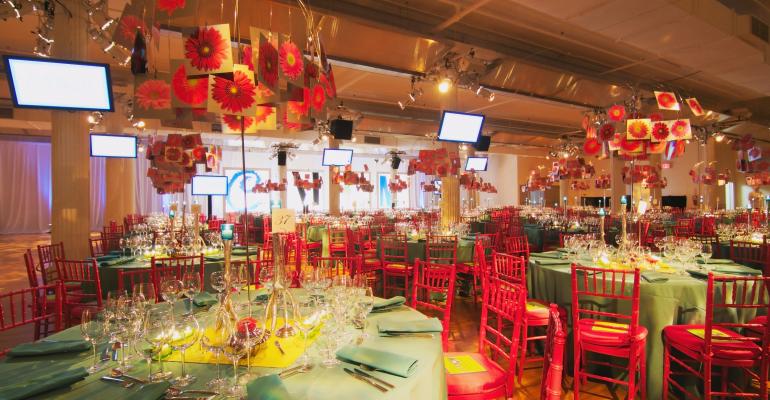Mention the word “theme” in a room full of event designers and be prepared for more than a few eye rolls. “The theme is done, at least for me,” states Ryan Hanson, CSEP, of Minneapolis-based BeEvents. “Corporate events are no longer just parties, they are communication vehicles. And event design is the process of crafting environments and creating experiences to communicate an organization’s business strategies. Just another theme will never accomplish that.”
On the other hand, David Merrell, president of Los Angeles-based AOO Events, maintains, “The days of theme events have definitely waned, but they won’t go away completely."
“Corporate clients still reserve the right to create an event that simply lets attendees let their hair down and have fun," he adds. "And, for better or worse, themed events have a tendency to accomplish that.”
Indeed, having fun—whether purposeful or just plain frivolous—is the objective of any good party, and event design is a critical component. “I think it's important to say that themed events can still be cool, too,” says Matthew David Hopkins of New York’s 360 Design by Matthew David. “There just needs to be some irreverent elements that buck the theme or turn it on its head. This ‘push and pull’ adds a layer that’s more fun than just an obvious theme.”
Rule 2: Be Subtle
Event designers are shying away from overtly themed events in favor of a more subtle look. And as is the case in most good design, understated can make a bold statement—often far more effectively. “I have definitely seen our more sophisticated clientele move toward a less obvious look,” Hopkins says. “They tend to favor clever design over a traditional theme.”
At a recent corporate event for cat litter maker Tidy Cat, Hopkins suspended vividly colored, oversized balls of yarn in plexiglass towers. Product was placed sculpturally on wall ledges. “The general trend is toward eclectic, incorporating familiar and surprising at the same time, and using elements that are recognizable in clever ways,” Hopkins says.
That element of surprise, Hanson notes, is what transforms a theme into a mood. “In the social and nonprofit world, the theme still resonates—but only if you can surprise with it, and present it in a new and interesting way.”
When presented with the task of creating a client-specified "Alice in Wonderland" event for an arts gala, Hanson decided to bypass Alice and focus instead on the Mad Hatter, who served as inspiration for and host of a tea for 500 guests. By incorporating such elements as framed photos of the Hatter and oddball “found objects” into the design (not to mention using linens that resembled bed sheets), Hanson achieved the “slightly crazy, egocentric” mood of the Mad Hatter’s world without overwhelming guests with a theme.
“Great design focuses the conversation in the direction you want your guests to go," he explains. "It doesn’t distract them from the reason they are at the event by trying to be too big—or too little—of a star.”
Rule 3: Tune into Tech
Whether it’s something as simple as a video projections and photo booths or as high tech as instant social media applications or interactive graffiti walls, technology in event design is growing exponentially. “First and foremost, a designer must have a working knowledge of technology and lighting,” Merrell says. “Designers should sit down with their techs and get an education. As boring as it may sound, once you understand what technology can do, you have a broader perspective on how to successfully bring it into your events.”
Hanson agrees. “You must have a strong technical team, specifically lighting and video partners," he says. "Digital content and experiences will continue to influence and infiltrate event experiences. That said, events will continue to look more and more like theatrical experiences and movies in so many ways.”
Rule 4: Hop on Pop
From film, TV and music to art, books and interior design, popular culture will always figure into event design. “I’m sure we are going to see a lot of art deco parties popping up this year as a result of ‘The Great Gatsby’ film that’s coming out this summer,” says Merrell, who credits TV’s "Mad Men" for the popular '60s vibe of a couple years back. “Keeping up on trends is always important, and there are so many ways to get clues as to what is hot. Just turn on the TV or open a magazine”--specifically, interior design magazines, he says. “They always are on point with what is hot and what is not.”
Indeed, creating inviting interiors—with hip, comfortable furniture and fashionable decor elements—is not only key to good event design, but essential for networking. “Those one-on-one conversations where business deals are made happen in these casual event environments,” Merrell says. “So it’s important to facilitate those conversations by creating such spaces.”
Rule 5: Find Your Focus
“Matching design to the budget is a process that should be done in a very thoughtful way,” Hopkins says. “I always design so that there is a ‘star of the show’ element—the one thing that gets attention as soon as the guests walk in the door. It sets the tone and gets the mood going.”
From there, Hopkins builds on his design, paying just as careful attention to what is not essential as to what is. “When tightening the budget, our first task is to look at each layer," he says. "The next is to prioritize the elements by choosing what will make the best impression. Finally, we remove elements that don't fit and aren't as important.”
See the full story in the May-June issue of Special Events, which is available to ISES members for free and to subscribers. Not a subscriber? We can fix that; just click here.





